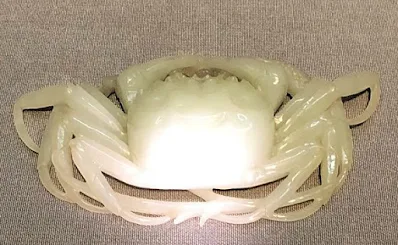These Chinese sculptures carved from white jade are all beautiful, but what interested me was not their beauty but hidden messages.
 |
| Incense burner in shape of cooking vessel, 18th to 19th century, Qing dynasty 白玉牡丹獅子飾鼎形香炉 |
The body of the incense burner (see the picture below) is decorated with a relief carving of Taotie, one of the four evil creatures of the world in ancient Chinese mythology. Nobody knows what this monster signifies, but some scholars believe that the Taotie motif is used to serve as a warning to people who covet power and wealth while others interpret the figure as representing a dog-headed, double-bodied monster that represents greed and gluttony. Source: Wikipedia
The second one is the paperweight in the photo below - a monkey on a horseback. What message do you think is hidden?
 |
| Paperweight in shape of monkey on horseback, 19th century, Qing dynasty 白玉馬上封候書鎮 |
Horseback means "soon" in Chinese while monkey or 猴 is pronounced the same as 候, which means a feudatory. So the message is that the recipient will be soon promoted to a feudatory. So, subtle, but I like it!
 |
| Paperweight in shape of crab, 19th century, Qing dynasty 白玉蟹書鎮 |
The message hidden in this crab-shaped paperweight is the passing of the Chinese imperial exam, "keju," with high marks. The pronunciation of passing the exam with high marks (甲) is similar to that of a crab shell.
You can see these white jade carvings at Tokyo National Museum.
(If you wish to post your comment but don't have a Google account, select "anonymous" from the drop down menu titled "comment as"!)
上から「白玉牡丹獅子飾鼎形香炉」、「白玉馬上封候書鎮」、「白玉蟹書鎮」です。いずれも清の時代の18~19世紀に作られました。きれいだとは思いましたがそれより面白いのはそれぞれにメッセージが隠されていること。
「白玉牡丹獅子飾鼎形香炉」の器体には「饕餮」という古代中国の怪獣の顔が浮き彫りにされています。定説はありませんが、ウィキペディアによると、権力や欲への警告とも言われています。
二つ目の「白玉馬上封候書鎮」は馬の背にサルがしがみついている様子です。中国語で馬上は「まもなく」、サルを意味する猴と候は発音が同じであることから、「間もなく候に封ぜられる、領土を与えられ諸侯に取り立てられる」ことを意味するそうです。
こういう繊細かつさりげない(もってまわった?)伝え方、嫌いじゃありません。。。 東京国立博物館にあります。
(Google アカウントを持ってない方がコメントする場合は、「Google アカウント」をクリックし、「匿名」か「名前/URL」を選択してからご記入ください!)
(Google アカウントを持ってない方がコメントする場合は、「Google アカウント」をクリックし、「匿名」か「名前/URL」を選択してからご記入ください!)



0 件のコメント:
コメントを投稿